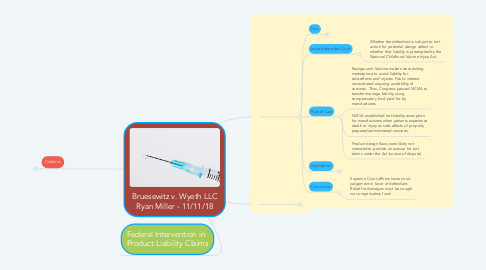
1. Citations
1.1. Bruesewitz v. Wyeth LLC, 562 U.S. 223 (2011)
1.2. Mutual Pharmaceutical Co., Inc., v. Bartlett, 570 U.S. 472 (2013)
1.3. Williamson v. Mazda Motor of America, Inc., 562 U.S. 323 (2011)
2. Federal Intervention in Product Liability Claims
3. The Case - IRAC
3.1. Fact
3.1.1. Parties
3.1.1.1. Plaintiff - Family of Hannah Bruesewitz
3.1.1.2. Defendent - Wyeth LLC, current owner of Lederle Laboratories
3.1.2. What Happened
3.1.2.1. Hannah Bruesewitz received DTP vaccine produced by defendant
3.1.2.2. Hannah suffered seizures and developmental delay resulting from the vaccine
3.1.2.3. Vaccine was properly manufactured and administered.
3.1.2.4. Vaccine makers pay tax into no-fault compensation fund as transfer of liability for vaccine injuries, thus encouraging continued manufacture incentive. Any injuries are intended to be compensated from that fund.
3.1.3. Procedural History
3.1.3.1. Bruesewitz family filed Federal Claim for relief under National Childhood Vaccine Injury Act of 1986 (NCVIA). Claim was denied.
3.1.3.2. Bruesewitz then family filed strict liability suit in Pennsylvania. Case transferred to Federal District Court per Wyeth request. Court agreed with defendant that suit was preempted by NCVIA. Third Court of appeals affirmed.
3.1.3.3. U.S. Supreme Court upheld the lower court ruling 6-2.
3.2. Issue before the Court
3.2.1. Whether the defendant is subject to tort action for potential design defect or whether that liability is preempted by the National Childhood Vaccine Injury Act.
3.3. Rule of Law
3.3.1. Background: Vaccine makers were exiting marketplace to avoid liability for side-effects and injuries. Public interest necessitated ongoing availability of vaccines. Thus, Congress passed NCVIA to transfer/manage liability using compensatory fund paid for by manufacturers.
3.3.2. NVCIA established tort-liability exemption for manufacturers when patients experience death or injury as side-effects of properly prepared/administered vaccines.
3.3.3. Product design flaws were likely not intended to provide an avenue for tort claims under the Act (source of dispute).
3.4. Application
3.4.1. Wyeth argues that the NCVIA provides ironclad protection for vaccine designers/manufacturers regardless of any unintended consequences. This risk, whether avoidable or unavoidable, is financially transferred to to the compensatory fund.
3.4.1.1. Court agrees with defendant that the fund is correct forum for damage relief and Wyeth is precluded from tort liability.
3.4.2. Bruesewitz family argues that the vaccine carried an avoidable design risk that negates seeking relief from the fund. Rather, they believe that relief may be sought via tort action because the Act does not mention defective manufacture.
3.4.2.1. Court finds that lack of reference to manufacturing defects does not imply allowance for tort relief. Rather, the legislature did not need to spell this out because it is a logical exemption.
3.5. Conclusion
3.5.1. Supreme Court affirms lower court judgement in favor of defendant. Relief for damages must be sought via compensatory fund.
4. Beyond the Case
4.1. Influence
4.1.1. Research & Development on critical vaccines can proceed with less concern for liability in design (poor manufacturing and labeling may still open to liability). The main concern for pharmaceutical companies lies in obtaining drug approvals, after which time there is essentially no more business risk associated with a properly vetted drug design.
4.1.2. Other industries should take note of the liability transfer realized by the creation of the NCVIA's compensatory fund. Where public interest may be aligned with limiting liability, firms should lobby for unification of risk under a similar structure. Specifically, they may wish to note that they are disincentivized from remaining a critical market. It is not often that industries wish to become more regulated, but this is a notable benefit.
4.2. Importance
4.2.1. Within the vaccination and broader medical industries, it set a level of protection from tort law where alternative regulatory schemes exist or where side-effects are unavoidable based on FDA standards.
4.2.2. Outside the medical industry, this case and other related cases shine a light on how the courts may view liability for product defects and negligence. Vehicle manufacturing and other industries with a high bar for product safety should pay close attention.
4.3. Impact
4.3.1. Mutual Pharmaceutical Co., Inc. v. Bartlett (2013) cited Bruesewitz's finding as it explored certain preemption protecting the medical industry from tort claims. In this case, it found that Mutual could not be held liable for labeling defects because federal law had otherwise prescribed how a drug was to be labeled.
4.3.2. Williamson v. Mazda Motor of America, Inc. begins to the explore the limits to federal preemption of tort law claims. In this case, the Supreme Court determined that vehicle manufacturers were not protected as a result of federal rules allowing them to choose between certain designs.
